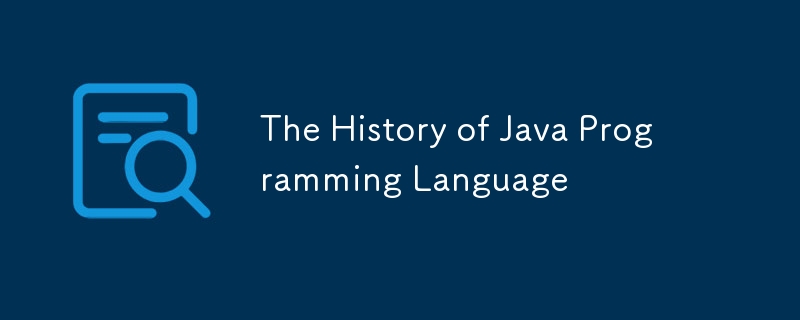

Java is one of the most popular programming languages in the world, known for its versatility, reliability, and efficiency. Its development and growth over the years have shaped much of the technology we use today. Here’s a look back at the history of Java.
1. Origins of Java
Java was developed by James Gosling, along with Mike Sheridan and Patrick Naughton, as part of the Green Project at Sun Microsystems. The language was originally designed for interactive television, but it quickly evolved into a general-purpose language.
1991:The development of Java began under the code name "Oak", inspired by an oak tree that stood outside Gosling's office. Later, the name was changed to Java after a type of coffee popular with the developers.
1995:Java was officially released by Sun Microsystems. Its "Write Once, Run Anywhere" capability quickly gained popularity due to its ability to run on any device with a Java Virtual Machine (JVM), making it platform-independent.
2. Key Milestones in Java Development
1996: Java 1.0 Released
The first official version of Java was released, which included the core libraries, JVM, and basic APIs. The focus was on applet development for web browsers, leading to the adoption of Java in web-based applications.
1998: Java 2 (J2SE)
The release of Java 2 (also known as J2SE) was a major milestone. It introduced the Swing graphical user interface (GUI) toolkit, Collections Framework, and improved performance. Java also started to be divided into three platforms:
Java SE (Standard Edition): For desktop applications.
Java EE (Enterprise Edition): For enterprise applications.
Java ME (Micro Edition): For mobile and embedded devices.
2004: Java 5 (Tiger)
Java 5 introduced significant language enhancements, including:
Generics
Metadata (Annotations)
Enums
Varargs (variable arguments)
The enhanced for-loop
These features improved code quality and developer productivity, making Java more powerful and modern.
2009: Oracle Acquires Sun Microsystems
Oracle Corporation acquired Sun Microsystems in 2009, gaining control over Java. This marked a new phase in Java’s evolution, with Oracle taking over the stewardship of the language and platform.
2014: Java 8
Java 8 was another major release that brought functional programming to Java with the introduction of Lambda expressions, Streams API, and the java.time package for better date and time handling. This release improved Java’s versatility and performance, especially for parallel processing and functional-style operations.
2017: OpenJDK
Oracle announced the shift of Java towards an open-source model with the OpenJDK project, providing free, open-source implementations of the Java Platform. Additionally, Java's release cycle changed from major versions every few years to a faster, six-month release cadence.
2018: Java 11
As a Long-Term Support (LTS) version, Java 11 introduced a number of enhancements, including local-variable syntax for lambda parameters, new APIs, and the removal of Java EE modules.
2021: Java 17
The next Long-Term Support version, Java 17, introduced new language features like sealed classes, pattern matching, and enhancements to records, further modernizing the language.
3. Java Today
Java continues to be widely used in web applications, enterprise software, mobile apps, cloud computing, and big data technologies. It powers major platforms like Android and enterprise servers through Spring Boot and Java EE. With its frequent updates and strong community support, Java remains a leading language in the software development industry.
4. Why Java Remains Relevant
Platform Independence: Java’s "Write Once, Run Anywhere" philosophy allows it to run on virtually any device, making it suitable for a wide range of applications.
Strong Ecosystem: Java boasts a vast ecosystem of frameworks (e.g., Spring, Hibernate), tools, and libraries that make development easier and faster.
-Security: Java’s security features, such as bytecode verification and runtime checks, have made it a trusted choice for secure applications.
Backward Compatibility: Java maintains excellent backward compatibility, ensuring that code written in older versions continues to work in newer releases.
Conclusion
Java’s rich history, from its inception in the early 1990s to its current prominence, reflects its adaptability and enduring relevance. As technology evolves, Java continues to stay at the forefront of the programming world, powering everything from enterprise-level systems to mobile applications and cloud computing.
The above is the detailed content of The History of Java Programming Language. For more information, please follow other related articles on the PHP Chinese website!




